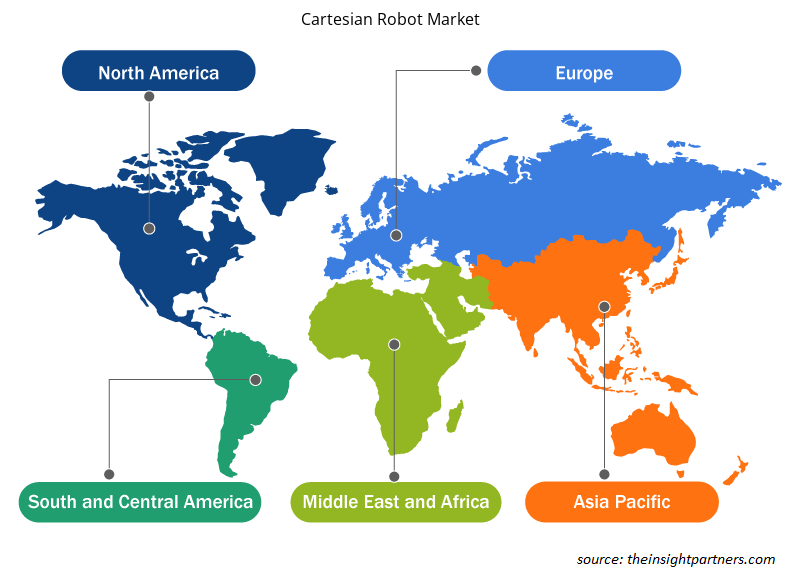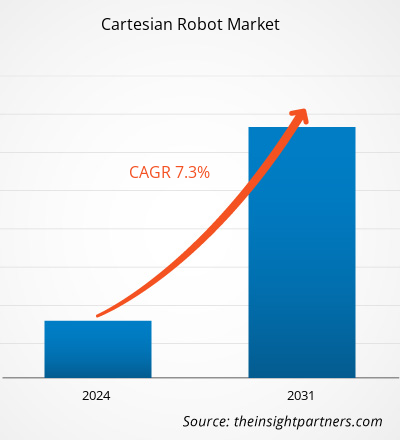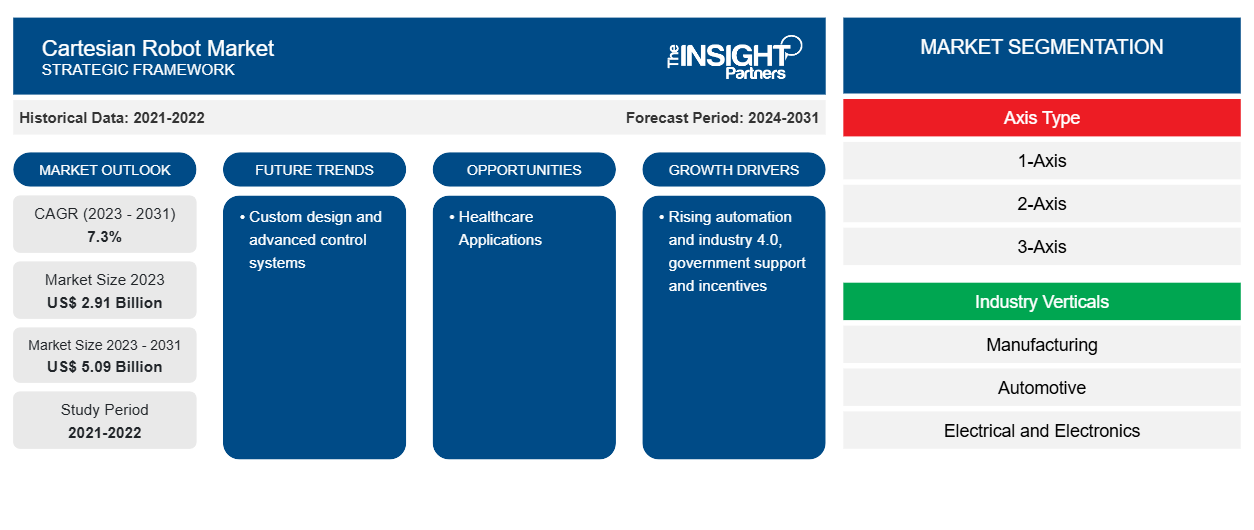Si prevede che la dimensione del mercato dei robot cartesiani raggiungerà i 5,09 miliardi di dollari entro il 2031, rispetto ai 2,91 miliardi di dollari del 2023. Si prevede che il mercato registrerà un CAGR del 7,3% nel 2023-2031. È probabile che la progettazione personalizzata e i sistemi di controllo avanzati rimangano le tendenze chiave del mercato dei robot cartesiani.
Analisi di mercato dei robot cartesiani
Robot cartesiani, robot lineari e robot a portale sono tutti termini per robot meccatronici che si muovono lungo assi lineari. I robot a portale assomigliano alle gru a portale e agiscono in modo simile. Tuttavia, i robot a portale possono fare di più che sollevare e spostare. Possono avere funzionalità specifiche in base ai requisiti.
Panoramica del mercato dei robot cartesiani
I robot cartesiani sono una tecnologia robotica semplice e popolare che i produttori utilizzano da decenni. Le aziende di tutti i settori e le applicazioni stanno raccogliendo i benefici di questa tecnologia scalabile. I robot cartesiani sono le piattaforme robotiche più versatili disponibili. Questa scalabilità si estende sia alle loro potenziali dimensioni fisiche che alla loro massima resistenza. I robot cartesiani possono essere piccoli come mini-stampanti 3D o enormi quanto si desidera. Ora sono disponibili molti enormi robot cartesiani che sono lunghi 50 metri (164 piedi) o più. Ciò è dovuto alla meccanica. Gli attuatori a cremagliera e pignone consentono ai produttori di costruire sistemi estremamente grandi. La loro meccanica è anche la più potente che troverai sulle moderne piattaforme robotiche.
Personalizza questo report in base alle tue esigenze
Riceverai la personalizzazione gratuita di qualsiasi report, comprese parti di questo report, o analisi a livello nazionale, pacchetto dati Excel, oltre a usufruire di grandi offerte e sconti per start-up e università
- Scopri le principali tendenze di mercato in questo rapporto.Questo campione GRATUITO includerà analisi di dati che spaziano dalle tendenze di mercato alle stime e alle previsioni.
Driver e opportunità del mercato dei robot cartesiani
Crescente automazione e industria 4.0 per favorire il mercato
Il mondo dell'automazione industriale sta cambiando radicalmente. I progressi in tecnologie come l'intelligenza artificiale (IA), la robotica collaborativa e l'integrazione IoT sono tra i pochi fattori trainanti di questa crescita. Innumerevoli produttori impiegano robot industriali per automatizzare i lavori, migliorare la sicurezza dei lavoratori e aumentare la produzione complessiva, riducendo al contempo gli sprechi e le spese operative. Man mano che i robot industriali diventano più comuni negli ambienti di produzione, aumenta la domanda di vari tipi di robot industriali adatti a determinate applicazioni e settori. Ad esempio, secondo un rapporto del 2024, ci sono più di 3,4 milioni di robot industriali nel mondo. Il rapporto robot-umani globale nel settore industriale è di 1:71. Le imprese industriali intendono investire il 25% del loro capitale nell'automazione industriale nei prossimi cinque anni.IoT integration are among the few drivers driving this growth. Countless manufacturers employ industrial robots to automate jobs, improve worker safety, and boost overall production output while lowering waste and operating expenses. As industrial robots become more common in manufacturing environments, there is a greater demand for various types of industrial robots to suit certain applications and industries. For instance, according to a 2024 report, there are more than 3.4 million industrial robots in the world now. The global robot-to-human ratio in the industrial business is 1:71. Industrial enterprises intend to invest 25% of their capital in industrial automation over the next five years.
Applicazioni sanitarie: un'opportunità nei robot cartesiani
I robot cartesiani svolgono un ruolo importante nell'automazione delle procedure mediche. A dicembre 2020, il sistema di angiografia Allia IGS 7 è l'ultima generazione del sistema di angiografia robotico di GE Healthcare per la terapia guidata dalle immagini. È stato presentato durante la riunione virtuale della Radiological Society of North America (RSNA) del 2020. Il sistema non era montato a pavimento o a soffitto, ma funzionava su un gantry su ruote, consentendo di parcheggiarlo fuori mano per un accesso più semplice al paziente o per la conversione in operazioni aperte. Il gantry robotico era guidato da laser per garantire un posizionamento preciso nella stanza e per consentire tecnologie di imaging e guida avanzate disponibili su sistemi C-arm fissi. L'applicazione di robot cartesiani in tali applicazioni mediche critiche sta creando opportunità sul mercato.
Analisi della segmentazione del rapporto di mercato dei robot cartesiani
I segmenti chiave che hanno contribuito alla derivazione dell'analisi di mercato dei robot cartesiani sono il tipo di asse e il settore verticale.
- In base al tipo di asse, il mercato dei robot cartesiani è suddiviso in 1 asse, 2 assi, 3 assi e 4 assi. Il segmento a 3 assi ha detenuto la quota maggiore del mercato nel 2023.
- In base ai settori verticali del settore, il mercato dei robot cartesiani è suddiviso in produzione, automotive, settore elettrico ed elettronico, alimentare e delle bevande, chimico e petrolchimico e altri.
Analisi della quota di mercato dei robot cartesiani per area geografica
L'ambito geografico del rapporto sul mercato dei robot cartesiani è suddiviso principalmente in cinque regioni: Nord America, Asia Pacifico, Europa, Medio Oriente e Africa e Sud America/Sud e Centro America.
L'Asia Pacifica ha dominato il mercato dei robot cartesiani. La crescente industrializzazione in paesi come Cina, India, Giappone e altri paesi dell'Asia Pacifica sta guidando la domanda di robot cartesiani nella regione. Il mercato dei robot cartesiani sta subendo uno sviluppo sostanziale in Nord America, che può essere attribuito a un aumento significativo in alcuni settori industriali come l'automotive e la produzione.
Approfondimenti regionali sul mercato dei robot cartesiani
Le tendenze regionali e i fattori che influenzano il mercato dei robot cartesiani durante il periodo di previsione sono stati ampiamente spiegati dagli analisti di Insight Partners. Questa sezione discute anche i segmenti e la geografia del mercato dei robot cartesiani in Nord America, Europa, Asia Pacifico, Medio Oriente e Africa e America meridionale e centrale.

- Ottieni i dati specifici regionali per il mercato dei robot cartesiani
Ambito del rapporto sul mercato dei robot cartesiani
| Attributo del report | Dettagli |
|---|---|
| Dimensioni del mercato nel 2023 | 2,91 miliardi di dollari USA |
| Dimensioni del mercato entro il 2031 | 5,09 miliardi di dollari USA |
| CAGR globale (2023-2031) | 7,3% |
| Dati storici | 2021-2022 |
| Periodo di previsione | 2024-2031 |
| Segmenti coperti | Per tipo di asse
|
| Regioni e Paesi coperti | America del Nord
|
| Leader di mercato e profili aziendali chiave |
|
Densità degli attori del mercato: comprendere il suo impatto sulle dinamiche aziendali
Il mercato dei robot cartesiani sta crescendo rapidamente, spinto dalla crescente domanda degli utenti finali dovuta a fattori quali l'evoluzione delle preferenze dei consumatori, i progressi tecnologici e una maggiore consapevolezza dei vantaggi del prodotto. Con l'aumento della domanda, le aziende stanno ampliando le loro offerte, innovando per soddisfare le esigenze dei consumatori e capitalizzando sulle tendenze emergenti, il che alimenta ulteriormente la crescita del mercato.
La densità degli operatori di mercato si riferisce alla distribuzione di aziende o società che operano in un particolare mercato o settore. Indica quanti concorrenti (operatori di mercato) sono presenti in un dato spazio di mercato in relazione alle sue dimensioni o al valore di mercato totale.
Le principali aziende che operano nel mercato dei robot cartesiani sono:
- ABB
- DENSO WAVE INCORPORATO
- Gruppo Midea.
- Società per azioni Seiko Epson Corporation.
- Shibaura Machine CO., LTD
- La Yamaha Motor Co., Ltd.
Disclaimer : le aziende elencate sopra non sono classificate secondo un ordine particolare.

- Ottieni una panoramica dei principali attori del mercato dei robot cartesiani
Notizie e sviluppi recenti sul mercato dei robot cartesiani
Il mercato dei robot cartesiani viene valutato raccogliendo dati qualitativi e quantitativi post-post-primari e secondari, che includono importanti pubblicazioni aziendali, dati di associazioni e database. Di seguito è riportato un elenco di sviluppi nel mercato dei robot cartesiani e delle strategie:
- KUKA Robotics ha presentato un nuovo sistema operativo per i suoi bracci robotici industriali e collaborativi all'Hannover Messe 2021. Il nuovo sistema operativo KUKA iiQKA.OS mira a essere "semplice da usare come un cellulare". Lo scopo fondamentale del nuovo design del sistema operativo è renderlo abbastanza semplice da utilizzare per i nuovi operatori senza richiedere una formazione specializzata. Questo è un obiettivo significativo nella progettazione del software, in particolare nel contesto della robotica collaborativa. (Fonte: KUKA AG, comunicato stampa, 2021)
Copertura e risultati del rapporto sul mercato dei robot cartesiani
Il rapporto “Dimensioni e previsioni del mercato dei robot cartesiani (2023-2031)” fornisce un’analisi dettagliata del mercato che copre le seguenti aree:
- Dimensioni e previsioni del mercato a livello globale, regionale e nazionale per tutti i segmenti di mercato chiave coperti dall'ambito
- Dinamiche di mercato come fattori trainanti, vincoli e opportunità chiave
- Principali tendenze future
- Analisi dettagliata delle cinque forze PEST/Porter e SWOT
- Analisi di mercato globale e regionale che copre le principali tendenze di mercato, i principali attori, le normative e gli sviluppi recenti del mercato
- Analisi del panorama industriale e della concorrenza che copre la concentrazione del mercato, l'analisi della mappa di calore, i principali attori e gli sviluppi recenti
- Profili aziendali dettagliati
- Analisi storica (2 anni), anno base, previsione (7 anni) con CAGR
- Analisi PEST e SWOT
- Valore/volume delle dimensioni del mercato - Globale, Regionale, Nazionale
- Industria e panorama competitivo
- Set di dati Excel
Report recenti
Rapporti correlati
Testimonianze
Motivo dell'acquisto
- Processo decisionale informato
- Comprensione delle dinamiche di mercato
- Analisi competitiva
- Analisi dei clienti
- Previsioni di mercato
- Mitigazione del rischio
- Pianificazione strategica
- Giustificazione degli investimenti
- Identificazione dei mercati emergenti
- Miglioramento delle strategie di marketing
- Aumento dell'efficienza operativa
- Allineamento alle tendenze normative





















 Ottieni un campione gratuito per - Mercato dei robot cartesiani
Ottieni un campione gratuito per - Mercato dei robot cartesiani